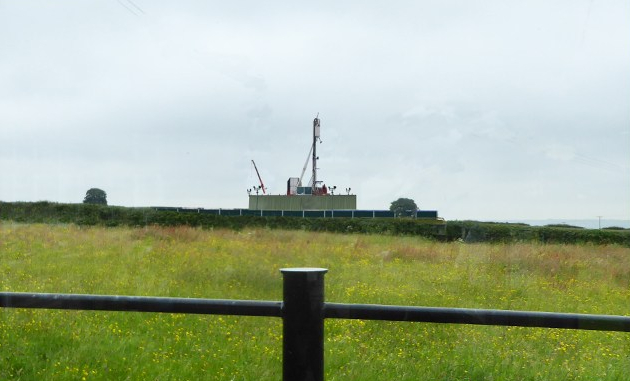
Photo montage of the proposed shale gas well site at Bramleymoor Lane, Marsh Lane. Montage: Eckington Against Fracking
The eight-day inquiry into Ineos shale gas plans for the Derbyshire village of Marsh Lane ended at lunchtime today.
The inspector, Elizabeth Hill, heard evidence from the company, Derbyshire County Council and the campaign group, Eckington Against Fracking.
Two QCs represented the council and the company.
The campaign group, Eckington Against Fracking, was represented for most of the inquiry by David Kesteven, its chair and a local gardener.
More than 30 members of the public spoke against the scheme, including the current and a former MP and the headteacher of the local school.
No-one, apart from Ineos witnesses, spoke in favour.
The inquiry concerned the first shale gas site in Derbyshire.
It was called because Ineos appealed to the Planning Inspectorate over what it said was unacceptable delays by Derbyshire County Council in deciding the application for a vertical coring well. Council officers had recommended the authority should not oppose the application at the inquiry but councillors voted by nine-one against.
The company wants to use a 60m rig to drill to a depth of 2.4km on land off Bramleymoor Lane. The purpose is to take samples of shale rock to assess whether the area is suitable for fracking. The Bramleymoor borehole would also be used as a listening well for nearby fracking. Ineos told the inquiry it was looking to source energy and raw materials for chemical businesses, including plastics, in the Ineos group.
In this review of the inquiry, we report on reaction from the three parties and look back on the key arguments and evidence from the past eight days.
Reaction
Ineos
A spokesperson for Ineos Shale told DrillOrDrop:
“INEOS Shale is disappointed that it was necessary for a Planning Inquiry to be held over the test drilling application at Marsh Lane – the kind of application that has been approved across England countless times before. However we are pleased to have an opportunity to discuss the science of the application and keenly await the decision of the Inspector.”

Lynn Calder, CEO of Ineos Upstream, at the end of the Marsh Lane inquiry. Photo: Eddie Bisknell
In an interview with local reporter Eddie Bisknell, Lynn Calder, Chief Executive Officer, Ineos Shale, attending the final day, said:
“We’re just standing here at the end of the two-week public inquiry from Bramleymoor Lane core well. We’re still a little bit disappointed that we had to sit in a room for two weeks, to take some core from the ground to test the geology. We don’t really think that helps anyone, dragging it out. We’d love to be back in the community talking about the development with a bit more data than we have today.
“But we’re also very pleased to have been given the opportunity to give our scientific case over the last couple of weeks and we’re also pleased that the local community had the option to have their say to the extent that they did. So hopefully, you know, everyone feels quite happy about that and now the decision is in the hands of the planning inspector.”
Asked if she was optimistic as she had been before the start of the inquiry, she said:
“Yes absolutely. We don’t want to pre-empt any decisions, obviously, and the decision is now with the planning inspector and we will respect her decision, but, yes, we feel that it has gone well.”
Derbyshire County Council
A spokesperson told DrillOrDrop:
“All parties at the public inquiry have put their case forward to the inspector and now we must wait for the inspector to weigh-up all the evidence put before the inquiry and reach a decision on whether or not the proposed development should be allowed to go ahead.”
Eckington Against Fracking

Eckington Against Fracking supporters outside the opening of the inquiry. Photo: DrillOrDrop
A spokesperson said:
“The appeal was about a planning application for an exploratory and listening well. The site is in the wrong place and too close to homes, schools and businesses.
“This well is a precursor to the development of massive industrialisation for the delivery of hydrocarbons that we do not need.
“A government-backed report on the security of energy supplies for the next 25 years modelled that the risk to security of supply was low.
“We need our children and grandchildren to become doctors, nurses, mental health practitioners, therapists, engineers, bricklayers, electricians and joiners, in well-paid, skilled jobs that secure our country’s sustainable needs. We don’t want them to be predominantly hgv drivers, moving toxic waste, silica sand and chemicals in order to serve an industry that is not sustainable and is toxic to humanity in many ways.
“We send a message from the many, not the few. This country belongs to the people, not the corporate giants that wish to ravish and pillage the north for the pockets of the few.”
Key issues and evidence
Listening well
The Bramleymoor Lane application proposed using the borehole as a listening well for fracking elsewhere.
Ineos revealed during the inquiry that the fractured well would be within 500m of Bramleymoor Lane.
Eckington Against Fracking described this news as “chilling”. Ineos said the inquiry could deal only with shale gas exploration but EAF said the listening well meant the application was also for shale gas appraisal.
Green Belt
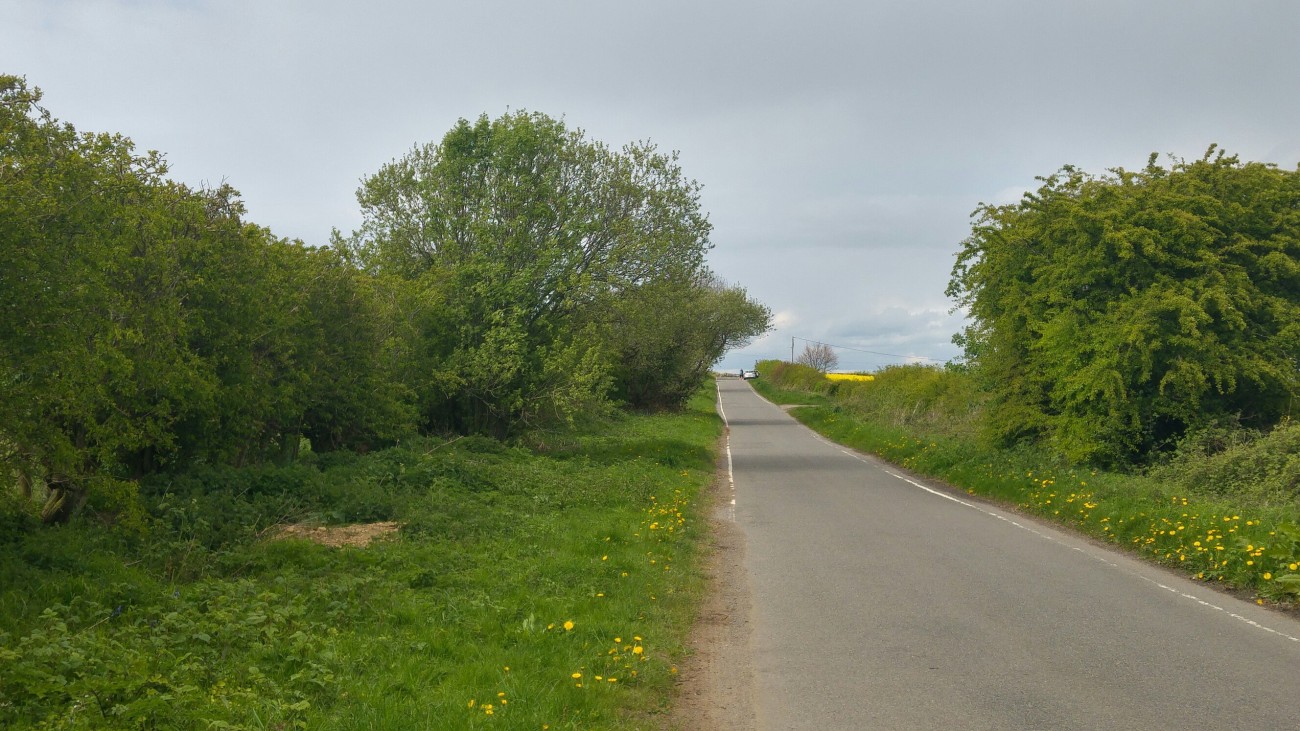
Bramleymoor Lane where Ineos wants to drill for shale gas. Photo: DrillOrDrop
Ineos maintained that the scheme would not encroach on or be inappropriate development in the Green Belt. The company said the Green Belt would “not be harmed in any way”. It cited inquiries for oil and gas schemes at Harthill in South Yorkshire and Bury Hill Wood (Leith Hill/Holmwood) in Surrey. But if the inspector ruled that it was inappropriate development, then the company argued there were very special circumstances that outweighed any harm to the openness of the Green Belt. These included the geology of the site and government support for shale gas exploration, the company said.
Derbyshire County Council said the Marsh Lane scheme would harm the openness of the Green Belt. It would have an urbanising effect and introduce unnatural landforms. There were no special circumstances that outweighed this harm, the council said, particularly because shale rocks cover a very wide area. The Marsh Lane was inappropriate development in the Green Belt, the council concluded.
Eckington Against Fracking urged the inspector to protect what it called “our little piece of paradise” from harm and encroachment. The group said Ineos had chosen a site in the Green Belt because land was cheaper there. It had made a choice not to use non-Green Belt land, the group said.
Alternative sites
Derbyshire County Council said there was no evidence before the inquiry that Ineos had considered sites outside the Green Belt, even though nearly half the exploration licence area, PEDL300, was non-Green Belt land.
Eckington Against Fracking witness, the local MP, Lee Rowley, said an executive of the oil and gas industry organisation had said drilling could happen in urban areas.
Ineos said this was “extremely prejudicial” evidence and should not have been raised. It said discussions with landowners about alternative sites were confidential and commercially-sensitive. The company said geologically the Marsh Lane site offered the best prospect of finding shale gas in the licence area. It could data from a former well drilled in 1987 alongside the site.
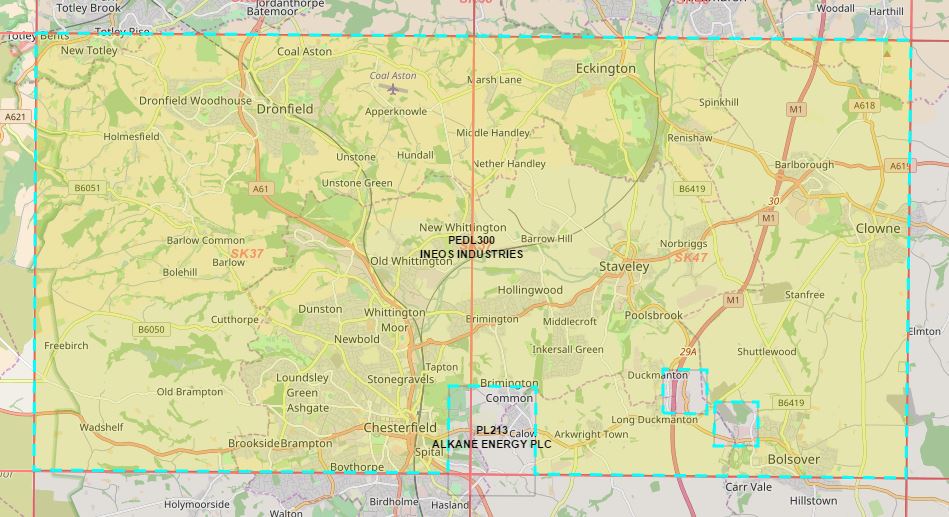
PEDL 300. Map: UK Onshore Geophysical Library
Local planning policy
Ineos evidence accepted there would be a “technical breach” of the local development plan which included a policy to protect and enhance the Green Belt. But the company maintained that overall the Marsh Lane scheme complied with the Development Plan.
Eckington Against Fracking said the proposal conflicted with local policies GS1, GS2 and GS6 that seek to protect the Green Belt, enhance the life of communities and limit noise and intrusion.
Derbyshire County Council also argued that the development was contrary to local planning policy.
Government support for shale gas
Ineos says great weight should be given to government support for shale gas, particularly the Written Ministerial Statement (WMS) issued in May 2018. This stressed the need for domestically-produced shale gas.
Derbyshire County Council said the WMS did not change policy or relax restrictions on development in the Green Belt.
Eckington Against Fracking said the Government did not refer to shale gas in its clean growth strategy and the fuel was not included in predictions on energy security. The group said the WMS was not relevant to the inquiry. The group said the UK government had a legal obligation to meet CO2 emission targets but no obligation to support the plastics industry.
Noise

The village of Marsh Lane from Bramleymoor Lane where Ineos proposes to explore for shale gas. Photo: DrillOrDrop
Both sides accepted that the area around the Bramleymoor Lane was quiet and peaceful, particularly at night.
Derbyshire County Council said the expected night-time drilling noise would be around 17 decibels above the present background noise. It said this should be taken into account when the likely impact of development noise was assessed. If the scheme were approved there should be a night-time noise limit of 35 decibels.
Ineos The company said the background noise level was not relevant when assessing the impact of development noise at night. The company said the night-time noise limit should be 42 decibels. It cited guidelines from the World Health Organisation which said there would not be sleep disturbance below this level. The company added that 42 decibels would be reduced to 27 decibels in homes with the windows open.
Eckington Against Fracking: The group disputed Ineos evidence on background noise levels. It said the company’s data used an outdated version of sound software. EAF also produced evidence that one noise monitor appeared to have been used at Bramleymoor Lane and Harthill at the same time.
Unreasonable burden
Eckington Against Fracking said if the scheme were approved there should be no drilling at night. The council pushed Ineos to improve sound-proofing around the top drive of the rig. Ineos said it had sourced the quietest rig possible and any further work to reduce noise would be an unreasonable burden, particularly because the site would not generate any money. It said drilling would cost about £6m. No night-time drilling would add about £2m and additional noise reduction measures would add £1m.
Traffic

Part of the traffic route to the proposed Marsh Lane site. Original photo: Eckington Against Fracking
Ineos said there were no reasons to oppose the scheme on traffic grounds. It said council officers and independent consultants for the council could not support the case against the scheme on these grounds.
Derbyshire County Council said its members were concerned about the impact of increased lorry traffic on local roads used for recreation by pedestrians, cyclists and horse riders. The lack of pavement or verges on the roads were also a concern, the council said.
Eckington Against Fracking said the Ineos proposals would result in “a huge loss of local amenity” and should be refused on traffic grounds alone. It says the Ineos assessment of the impact of HGV traffic was inaccurate.
Community impacts
The headteacher Marsh Lane Primary relayed concerns from local parents who said they would remove their children if the scheme went ahead.
Ineos was criticised for not liaising with local people and organisations and for describing people living the site as “noise sensitive receptors”. The company denied that it had “shied away” from community engagement. It said wanted a community liaison group.
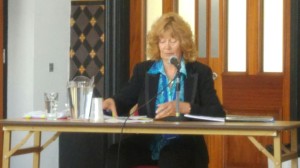
Jenny Booth giving evidence on impacts on tourism. Photo: DrillOrDrop
Tourism
Eckington Against Fracking said the Marsh Lane scheme would not be compatible with the local strategy to promote the area for tourism, estimated to add £100m to the local economy. The two industries could not co-exist successfully, the group said. Ineos said there was no reason why the scheme would affect tourism.
Harthill inquiry
Ineos said great weight should be given to the approval of its similar proposal for Common Road, Harthill, after a public inquiry. Derbyshire County Council and Eckington Against Fracking said the two sites were very different and the inspector’s decision on Harthill wasn’t relevant.
Climate change
Eckington Against Fracking and Friends of the Earth said the climate impacts of the scheme should be considered. Ineos said the climate footprint of the exploration project was negligible.
Airfield
The inquiry heard that the Coal Aston airfield near the site could have to close for 3-6 months during the drilling phase. Ineos discounted concerns about the effect of emergency venting on light aircraft. Eckington Against Fracking asked for a condition to protect the airfield, should the scheme be approved.
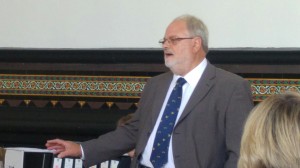
Professor Peter Styles giving evidece on subsidence. Photo: DrillOrDrop
Subsidence
The inquiry heard concerns about the impact of shale gas developments on areas where there had been former mine workings. Ineos dismissed a presentation by Emeritus Professor Peter Styles as not relevant because it was about fracking.
- For a quick summary on each day you can visit the DrillOrDrop Marsh Lane inquiry page.
DrillOrDrop reported from each day of the Marsh Lane inquiry. This reporting was made possible by individual donations from DrillOrDrop readers.
Categories: Regulation



Absolute twaddle PhilipP.
For all the oil and gas produced in the USA, less will be produced elsewhere to supply their market. You do recall USA were rather large importers of the stuff? Maybe they will increase industrial output but will a car factory in USA produce greater emissions than if it was in Mexico supplying cars into USA?
Elsewhere in USA their technology is allowing other forms of energy to be utilised so that their levels of emissions will not increase significantly. You need to look at other countries to see where the big increases in emissions are and will come from-that is why Trump pulled out of Paris. Yes, some of us do understand the climate change issues and therefore do not look for the easy target, which is not the real problem. Same as plastic is not the real problem, the uncontrolled disposal of it is. When sewage was an all too common sight in British seas did we ban curry houses? No, we made sure that the newly privatised water companies spent money on making sure sewage did not get into the sea (still not perfect, but a lot better than it was.) But, like most of these issues, it is so much easier for politicians to be lobbied and then introduce instant “fixes” via bans, to placate those who have no understanding of the issues.
You have a fanciful way of avoiding points raised and winning arguments inside your head Martin, but that’s as far as it goes.
CO2 emissions are cumulative. The CO2 produced by the United States over 100 years ago, when it was overtaking Britain for industrial output, coal and petroleum emissions etc, is still having and impact today. China and other major polluters have ramped up output only recently by comparison. Total impacts, when integrated over time mean that the Western industrialised nations carries the major burden of responsibility to lead by example in progressively tackling the emissions issues, which mean talking and negotiating at the top tables.
You’ve bought Trumps cover story (the ‘others are worse at it’) I see but then seeing him go off and deregulate fossil fuel extraction from US National Parks and nearly all US coastal areas, appointing a brazen global warming denier (while saying its all a hoax himself) to head the EPA, is more revealing of the truth. He doesn’t care. He lies – get used to it Martin. Sad to see people buying the lies imagining them to be true – though it makes Trump smile.
You mean the CO2 produced during huge industrial output to maintain the free world during two World Wars? And then you want the country to be disadvantaged for that? One little stat for you. After D-Day a tank regiment of around 125 tanks, replaced 800 BEFORE they broke out of Normandy. That sort of industrial output did indeed produce some CO2.
But there are billions in Europe and the rest of the world who are smiling because of it.
A very strange attempt to “compensate” for history. Next, you will want to stop oak tables in the UK to compensate for those trees sacrificed to build Victory and the rest of the fleet!
Get used to it PhilipP-it ain’t going to happen. Sorry that it spoils your narrative but I’m sure there will be lots more you can find to criticise Trump for.
Ah , I see you’re stuck in the past and want to drag the future down with you. Damn the next generation eh.
“The CO2 produced by the United States over 100 years ago.”
Now, remember who said that? If you can’t, then perhaps nursey will remind you.
It is so clear when you have posted something silly, because you try and deflect it was you who posted it, rather than it was not silly! Of course, the shift change could have occurred and the record not passed on. Notebooks are the answer, but they have to be read before the new shift starts.
Better if you try and stick to the point. though your attempts at deflection Martin are entertaining e.g. with your own goal above suggesting that lowering emissions would lead to a disadvantage (on our side) when all sides in the World War conflicts were industrialised nations – who all need to lower their emissions.
If you’re short of information on petroleum developments in the USA circa 1918 (100yrs ago etc) let me help: https://aoghs.org/petroleum-pioneers/burkburnett-oil/
Oh dear me. Struggling, but still drowning. How industrialised were China and India? Glug, glug.
How easily the antis slip into fiction. There are historic records, you know.
But, these little interludes are useful reminders of how the misinformation system works. Put anything out there, someone might believe it, and if it is challenged as silly, come up with another silly one. But then, most people know how RT has been “educating” in the same way, so are quite used to the technique.
Predicted response. Another own goal… hope your habit isn’t catching (England v Colombia tonight). China’s move toward greener energy and global warming mitigation are accelerating past the efforts of all other nations. They’ve had to. The glaciers at the top of the world – the Tibetan Plateau are receding rapidly – that’s where all there water comes from. Not to mention their air pollution issues.
That won’t put it at a disadvantage – far from it, the Western nations actually wanting to move will start to see it as a new leader in that field before long (if not already). I see western interests still pushing O&G development in India, but nevertheless they’re getting a growing taste for renewables and smart networks.
https://www.theguardian.com/environment/2018/jan/10/china-on-track-to-lead-in-renewables-as-us-retreats-report-says
[Post corrected at poster’s request]
Philip P, I was in NE India for the whole of March, 4,500km trip around Manipur, Meghalaya, Nagaland, Assam and Arunachal Pradesh. The previous two trips to the same region were around 3,500km each. We saw zero wind turbines and zero PV panels (apart from a few portable PV units about 6″ square villagers who don’t have mains electricity charge their mobiles on). There is a reasonable amount of old hydro, particularly in the lower Himalayas below Tibet (China). Power stations appear to be coal / oil and possibly some gas. Apart from tea one of the biggest industries in Assam is oil and gas production. This is expanding. The biggest operator appeared to be Indian Oil. No western interests that I saw. In Meghalaya coal mining by hand is prevalent, a lot of this is exported to Bangladesh by truck.
I also have read about India’s great switch to renewables – however it certainly hasn’t happened in NE India. And the grid infrastructure across India will not accommodate any large scale uplift in renewables. It may be that projects will be smaller and more localised however they will still need to improve the national grid in order to support the renewables with conventional electricity, particularly as the middle class evolves which is growing exponentially.
As India has had the money to connect all with decent water since the 1990’s and hasn’t, then I would not hold out much hope of a national grid; by the time any cash or aid gets to the people most has been siphoned off into the pockets of those it has to travel through.
Some southern areas still have operations without anesthetics.
But then again India is a very large country…..
All should find this interesting, I wonder how accurate it is? A quick look at France, Germany and UK shows France miles ahead (nuclear), UK in the middle and Germany behind (coal / lignite and not too sunny now).
https://www.electricitymap.org/?wind=false&solar=false&page=country&countryCode=FR&remote=true
Presumably England’s consumption is up whilst Germany’s is down tonight, at least for another 45 mins.
Thanks Paul. Interesting Project … keep wondering how solar is centrally quantified when it is mostly downstream and often off grid. I might ask the guys at ‘Tomorrow’
Interesting, and no sign of the Russian gas for the UK?
Russian gas? This is an electrcity map – does it show gas also somehow? That would be interesting. Our consumption of Russian gas is low if any. Although I recall a forward contract in place which will start shortly. Of course gas imported from Europe (not Norway) could include a component of Russian gas.
The electricity generation map for GB at 0825 hrs shows how dependent on nuclear and gas we are. Woodchips more than wind or solar, but solar will pick up significantly and then drop to zero tonight. Wind will stay very low as it has for 5 weeks now. We are importing more from France via the IC than John Powney’s dream wind is producing according to this map. In fact the Fench IC is providing us double our wind generation – even some coal running as back up for no wind……Confirmed by Gridwatch but no doubt they use the same input data. Onwards with renewables. Install another million wind turbines and we might get rid of gas….
But you all keep saying that gas is producing our electric and that gas comes from Russia? Isn’t that one of your {mis} claims for the justification of shale gas extraction?
It’s interesting that those with the highest output of renewable energy is mainly hydro…this technology is so old; why did we stop (old cotton mills used to run on this power before coal and steam)? Don’t we have free running water in the UK; have we missed something here?
Produce the (renewable) power first and demand second, then we can all enjoy a cleaner planet. It’s about attitude; remember that old adage, waste not, want not? Energy is not a right, it’s a privilege.
No we don’t Sherwulfe, I have never said we get any significant gas from Russia. There are some future contracts in place apparently. There are a lot of local hydros in Cumbria and some in North Lancs. Unfortunately they need water. I walked by the NT one at Hartsop near Patterdale on Monday – generation = zero. No doubt the same for the rest of the smaller ones.
Hydro works really well in Norway and British Columbia, Canada. Geography is the key. We may have opportunities in Scotland and the Lake District but no one is going to recommend damming large valleys in this day and age (like Haweswater was for example). Actually Haweswater is almost empty – the submerged village is appearing again.